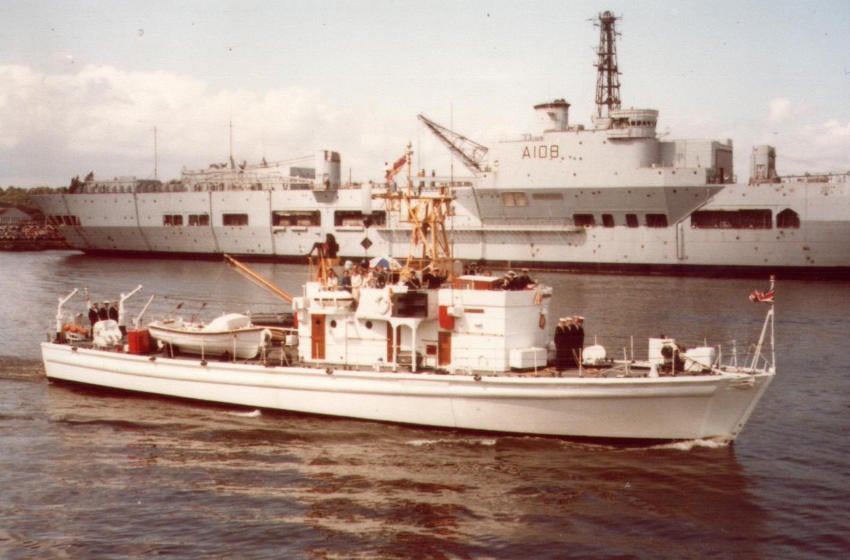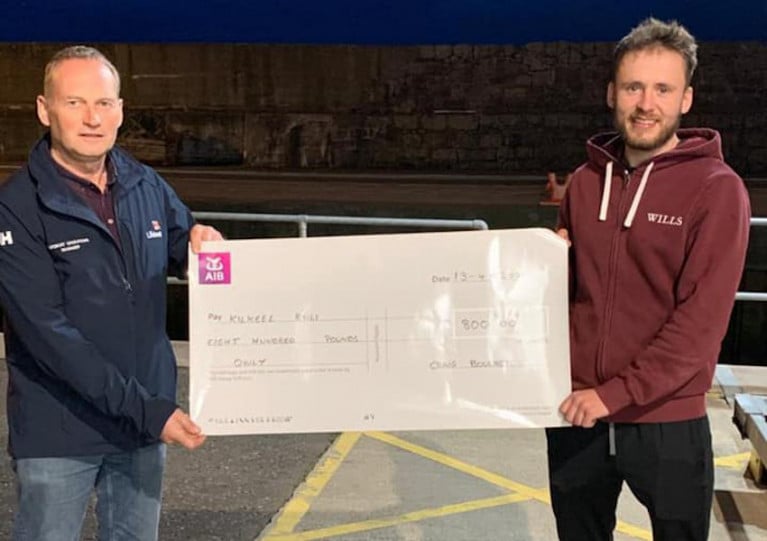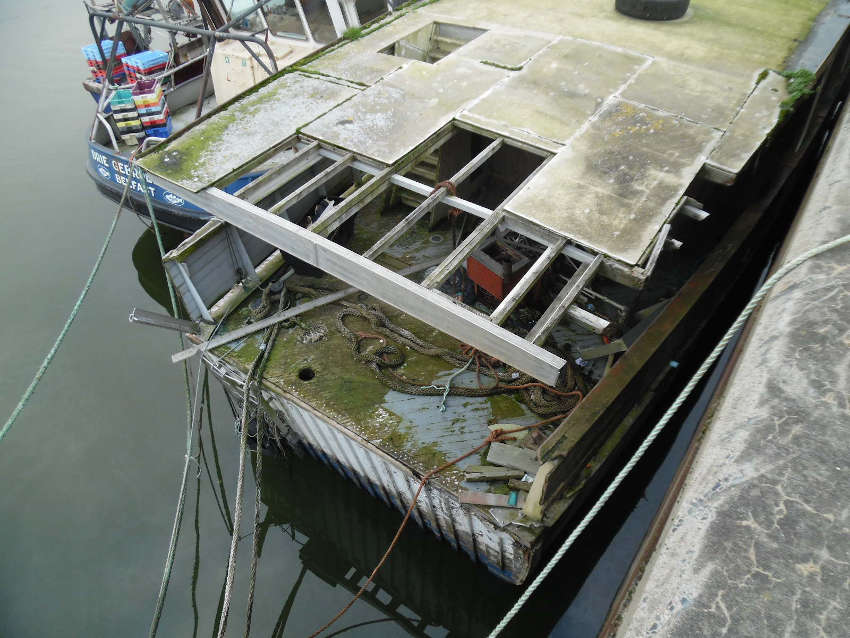Displaying items by tag: Kilkeel
The old minesweeper HMS Enterprise has all but submerged in Kilkeel Harbour in Northern Ireland, as Afloat.ie reader Lee Maginnis has shared with his.
His recent images of the vessel show a significant degradation from the last update in autumn 2022, when warning signage was affixed to the boat reading Abandoned Vessel - Danger Keep Out”.
As of Wednesday 22 March, the hull has almost entirely sunk beneath the water line in the Co Down harbour — an ignoble end for the former Royal Navy minesweeper which has a storied history.
“The photos say it all,” Maginnis tells Afloat.ie. “Don’t we look after our heritage well.”
 Another angle showing what’s left of the HMS Enterprise dockside at Kilkeel Harbour | Credit: Lee Maginnis
Another angle showing what’s left of the HMS Enterprise dockside at Kilkeel Harbour | Credit: Lee Maginnis
Signage Warns Public Away From ‘Abandoned’ Ex-Minesweeper HMS Enterprise in Kilkeel
Afloat.ie reader Lee Maginnis has provided an update on the current condition of the old minesweeper HMS Enterprise in Kilkeel Harbour, and the news is not good.
The former Royal Navy minesweeper with a storied history was previously anchored in Carlingford Lough, and made the news 10 years ago when it broke its moorings and beached in Rostrevor Bay a number of times.
Since relocated to Kilkeel in Co Down, the vessel has fallen into serious disrepair. Since Maginnis’ previous update to Afloat.ie in late 2020, the boat now bears signage that reads “Abandoned Vessel - Danger Keep Out”.
 The warning sign taped to the remains of the HMS Enterprise in Kilkeel | Credit: Lee Maginnis
The warning sign taped to the remains of the HMS Enterprise in Kilkeel | Credit: Lee Maginnis
“Sadly HMS Enterprise has succumbed to the elements after languishing for years in Kilkeel Harbour,” McGinnis says. “She has been moved so that her bows are now in shallow water, her stern is underwater and she is listing to one side. A sad sight.”
If any Afloat.ie readers have any more information about the Enterprise and its current situation, please get in touch or let us know in the comments below.
 The HMS Enterprise as seen by Afloat.ie reader Gerard Rooney in Kilkeel this past August | Credit: Gerard Rooney
The HMS Enterprise as seen by Afloat.ie reader Gerard Rooney in Kilkeel this past August | Credit: Gerard Rooney
First Call out for New Crew Member as Kilkeel RNLI Goes to the Aid of a Windsurfer in Carlingford Lough
Kilkeel RNLI came to the aid of a windsurfer who got into difficulty in Carlingford Lough yesterday.
The volunteer crew were requested to launch their inshore lifeboat by Belfast Coastguard at 2.30 pm yesterday (Monday, 1 August) after the alarm was raised by a member of the public that a windsurfer was thought to be in difficulty in Carlingford Lough.
The lifeboat helmed by Raymond Newell and three crew members onboard, headed to Carlingford Lough in moderate sea conditions and navigated the lifeboat into the shallower sea grounds of Mill Bay.
A lone windsurfer was soon located in the area along with his board. With the wind direction and tide forcing the windsurfer further away from the land the surfer was finding it difficult to make it back ashore.
The crew were able to get the casualty into the lifeboat along with his windsurf board and he was then safely transported back into Greencastle where the Kilkeel Coastguard shore team were waiting to assist.
This was also trainee volunteer crew member Brandon Campbell’s first official call out.
Speaking afterwards, Kilkeel RNLI Helm Raymond Newell said: ‘Thankfully, we were able to assist in bringing the windsurfer safely back to shore. Given the good weather, there are a lot more people around and on the water and we would like to advise people to always carry a means of calling for help, always wear a lifejacket and other appropriate protection and always check the weather and tides before going to sea. Should you get into difficulty or see someone else in trouble, dial 999 or 112 and ask for the Coastguard.’
Lifeboats Come to Aid of Seven People and a Dog After Tall Ship Runs Aground in Carlingford Lough
RNLI crews from Kilkeel in Co Down and Clogherhead in Co Louth launched to the aid of seven people and a dog last week after their 80ft tall ship ran aground in Carlingford Lough.
The lifeboat volunteers launched their inshore and all-weather lifeboats at 3.30pm on last Tuesday 24 May following a report that a vessel had run aground on a falling tide earlier in the day close to Narrow Water Castle while on passage from Newry to Ballycastle in Northern Ireland’s North Antrim coast.
Greenore Coast Guard and Kilkeel Coastguard were also tasked. But with no one in immediate danger, a decision was made to hold off on launching the lifeboats to assist until the tide came up.
With the rising tide, the ship began to take on water quickly so upon arrival, lifeboat crew transferred on board with two salvage pumps to take the ingress out.
The seven crew of the tall ship and the dog were transferred onto their smaller inflatable tender which was safely escorted to Warrenpoint Harbour by Clogherhead RNLI’s all-weather lifeboat.
Meanwhile, two more pumps were put aboard the vessel and after two-and-a-half hours the ship became level with the sea again. Subsequently the tall ship was towed into the channel where it was able to continue under its own steam to the nearest safe port at Warrenpoint Harbour escorted by both lifeboats.
Speaking following the callout, Kilkeel RNLI helm Gary Young said: “Thankfully, no one was in any immediate danger, but the ship’s crew safely moved to their tender once the vessel began to take on a lot of water as the tide rose.
“There was great teamwork between ourselves and our colleagues from Clogherhead RNLI and Greenore Coast Guard. We had to work quickly to get the salvage pumps on and to remove the ingress of water which we were delighted to see working in order to save the vessel.”
Annual Boat Fishing Competition Raises £1,300 for Kilkeel RNLI
On Tuesday last week (7 September), Merwyn Hanna MBE, president of Kilkeel RNLI and chair of the lifeboat station’s fundraising branch, received a cheque for £1,347.65 from Raymond “Speedy” Newell following a successful fishing competition off the Co Down coast.
When the fog lifted, 14 boats took part in the annual Kilkeel RNLI Boat Fishing Competition and after two hours a total of 382kg of mackerel was landed.
The winning boat Tuskar, with skipper WM Kearney, landed 81.74kg. In second place, Dawn Mist with skipper Stephen Jones landed 72.4kg and third place went to Harvey Jake, with skipper Shane Maginn, landing 53.44kg.
There was a tie for the heaviest fish caught and prizes were given to skipper Joshua Hillis on the Hannah Hillis and Stephen Jones on the Dawn Mist.
John Fisher, Kilkeel RNLI’s lifeboat operations manager, said: “The weather during the day wasn’t promising but when the fog lifted, we had a great turnout of boats.
“We would like to thank Russ Shepcar of DR Marine for the use of his store, those who took part and the ladies for the burgers and drinks.
“Thanks to the volunteer crew for ensuring the event was carried out safely and finally a special thanks to Speedy Newell for organising the event. All in all, it was a great community effort.”
Kilkeel RNLI launched their inshore lifeboat to the aid of two fishermen stranded in Carlingford Lough on Saturday (22 May).
The fishermen had been lifting creels just off Cranfield Point on the Northern Ireland side when the 25ft boat’s propeller became fouled by a rope and was unable to move.
Arriving on scene in good conditions, the lifeboat volunteers checked on the fishermen’s wellbeing before two crew set about the task of entering the water and cutting the rope away from the propeller.
After checking that all was sound, the lifeboat crew let the fishermen go on their way and proceeded back to base.
Speaking afterwards, Kilkeel RNLI helm Gerry Smyth said: “The two fishermen could have drifted into the shipping channel so they made the correct call by contacting the coastguard on 999 or 112 and seeking assistance. We were pleased to help and have a successful outcome.”
Kilkeel RNLI came to the aid of five people on Saturday (17 April) when their 10m yacht became stranded at Narrow Water Castle on the Northern Ireland side of Carlingford Lough.
The volunteer crew launched their inshore lifeboat at 4.05pm on Saturday to assist the yacht which had lost power and was at anchor at high tide.
The five people on board the yacht, all of whom were wearing lifejackets, were in no immediate danger.
On their way to the stricken yacht, with good visibility in a Force 4 south easterly wind, the Kilkeel RNLI crew were asked to attend to a separate report of one person in the water at Ross’s Monument Corner.
The person in the water had become separated from his catamaran board but by the time the lifeboat had reached the scene he had made his way ashore and Kilkeel Coastguard were attending to him.
Having ascertained that all was well, Kilkeel RNLI continued on their way to the yacht.
Arriving on scene, Kilkeel RNLI confirmed that the yacht crew was safe. A tow line was passed and secured to the vessel and on an ebb tide, the lifeboat then proceeded to Carlingford Marina with the vessel under tow.
Speaking afterwards, the skipper of the yacht said: “After a brilliant sail from Carlingford, up past Narrow Water, we had an engine failure at the worst possible moment. On a lee shore, we dropped anchor, but with a falling tide we were getting perilously close to going aground.
“We were very, very glad to see the boys in orange heaving into view.”
48-Mile Fundraiser Raises £800 for Kilkeel RNLI
Craig Boucher of Hybrid Health and Performance in Kilkeel recently completed a 4x4x48 challenge to raise funds for his local RNLI lifeboat station in the Co Down town.
Craig ran four miles every four hours for 48 hours and was generously supported by friends who donated a total of £800.
Speaking after his effort, Craig said that he had to walk the last eight miles because his knees were in “complete agony’” with every step and he didn’t want to force an injury.
John Fisher, lifeboat operations manager with Kilkeel RNLI, was delighted to receive the cheque and said: “It was a fantastic effort by Craig. That was almost two marathons in 48 hours, an unbelievable achievement from only three weeks of training.
“The donation is very welcome and the £800 will be put to good use in saving lives at sea.”
Ex-Minesweeper HMS Enterprise Looking Worse for Wear in Kilkeel
Afloat.ie reader Lee Maginnis has sent us images of the old minesweeper HMS Enterprise looking worse for wear in Kilkeel Harbour.
The former Royal Navy minesweeper was previously anchored in Carlingford Lough, and made the news nine years ago when it broke its moorings and beached in Rostrevor Bay a number of times.
Built in 1957 by MW Blackmore & Sons and once part of a fleet of minesweepers, the Enterprise is also renowned as one of the first vessels to discover the wreck of the Titanic in the North Atlantic 34 years ago.
Later the historic boat was refitted as a radio ship as part of a cross-community project called Pirates for Peace, as the Belfast Telegraph reports, and was subsequently sold on to an owner based in Australia with plans to relocate it there.
But the mahogany- and teak-hulled boat has since fallen into serious disrepair, as reflected by its state at its current Co Down harbour mooring, leaving questions about its future.
 HMS Enterprise at Chatham in 1981, with HMS Triumph in the background | Photo: Wikimedia
HMS Enterprise at Chatham in 1981, with HMS Triumph in the background | Photo: Wikimedia
If any Afloat.ie readers have any more information about the Enterprise and its current situation, please get in touch or let us know in the comments below.
Kilkeel Lifeboat Rescues Windsurfer Off Cranfield Point
Kilkeel RNLI launched to the rescue a windsurfer who got into difficulty off Cranfield Point on Saturday (14 November).
The volunteer crew set out on their inshore lifeboat at 3.25pm on Saturday as part of a multi-agency tasking that also involved Kilkeel Coastguard, Greenore Coast Guard and the Irish Coast Guard helicopter Rescue 116 from Dublin.
Onshore, Kilkeel Coastguard had spotted the sail of the windsurfer just north of Carlingford Lough’s shipping channel and directed lifeboat helm Gerry Smyth towards the casualty, who had been one of a group of eight.
The other seven members of the group had made it safely to shore. In Force 5-6 winds and in a moderate sea, the casualty and his gear were taken onboard.
The exhausted casualty was checked by the lifeboat crew for injury, water inhalation and the effects of the cold conditions. He was then made comfortable and brought safely ashore. The lifeboat returned at 4.15pm where the grateful surfer was met by Kilkeel Coastguard.
Speaking following the callout, Kilkeel’s lifeboat operations manager John Fisher said: “The crew did everything in a thoroughly professional manner and we would like to wish the casualty well.
“Because of Covid-19, the crew have been restricted in their training exercises but this afternoon they demonstrated their skills with this rescue also highlighting how well multiple agencies work together.”
The crew readied to launch for a second time over the weekend at 2.15pm yesterday (Sunday 15 November) following a call that an EPIRB had been activated.
However, after an extensive local onshore search it was found that the EPIRB was faulty and was located in a boat owner’s garage.





























































